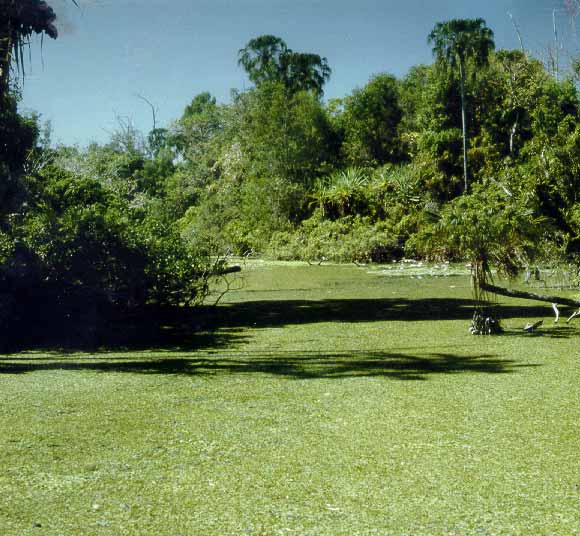Why worry about invasive species?
Invasive alien species all belonged somewhere originally, but can cause enormous economic, ecological and social/cultural costs when they establish elsewhere. We worry about invasive species because they have a demonstrated capacity to negatively impact on the environment, human health, industry and our society. The cost incurred may be a loss of biodiversity or ecosystem function, economic loss (eg. dollars spent or earnings lost) and/or cultural deprivation (eg. inability to collect traditional foods).

Salvinia choking a river in the Northern Territory
The Australian perspective
In 1999 it was estimated that Australia had more than 2700 weeds, which represents 16% of Australia's wild plant species. We have introduced 14 species of mammals, 6 reptiles, 1 amphibian, 31 fish and the very conservative estimates of the invertebrates suggests greater than 318 species. The number of fungi and micro-organisms that have established is anyone's guess. This is a pretty disturbing picture, but what is equally disturbing is that exotic species continue to arrive despite our efforts (Low 1999).
The costs associated with responding to these pests and weeds runs into hundreds of millions of dollars annually. For example, in Australia in 1995 the national budget for herbicides was estimated at $452 million, for insecticides $170 million and for fungicides $84 million (National Weeds Strategy 1999). As well as pollution and health risks associated with chemical application, additional costs are associated with loss of agricultural or horticultural production, and damage to the natural environment resulting in loss of biodiversity and ecosystem services.
The cost of weeds to agriculture in Australia is estimated at $4 billion/year (source: CRC Weed Management). The environmental cost is expected to be similar.
These costs are associated with pests and weeds that have already arrived on the continent; more can be expected to arrive in the future.
However, because of lessons already learned, the Commonwealth Government has established the Australian Quarantine and Inspection Service (AQIS) to monitor, regulate and manage the introduction of exotic species into Australia. AQIS and state and territory agencies use a number of instruments and criteria, such as risk assessment tools, prohibited lists, and potential weed lists. You'll learn more about these when working on weed management in Topic 4 - Managing threats.
A final worry
It has been observed that introductions of invasive alien species are increasing sharply in many countries, while the mechanisms for excluding or eradicating alien species have been withdrawn or progressively weakened (e.g. Mack et al. 2000; Perrings 2002). And of course the methods of dispersal - travel and trade - are becoming potentially more effective.
Responding to the threat posed by invasive species
So, it is the detrimental effects of invasive species that provide the motivation for this enormous expenditure on the surveillance for potential invaders and control and management of established invasive species.
Shortly we'll ask you to look at Table 2.1 (see activity below), where we have provided examples of invasive species and the area of concern they impact upon. For environmental pests & weeds, we also note the ecological scale(s) at which they operate. In examining the examples provided in Table 2.1 you will see some of the responses to these threats and why in a number of instances, the responses themselves are part of why we worry.
Activity 2.1
Now we'd like you to become familiar with a small sample of invaders, provided in Table 2.1.
While exploring the Table consider the following questions:
- Why do we need to understand the impacts of invaders?
- How can knowledge of impacts contribute to better management of invaders?
Post your responses to the discussion forum.